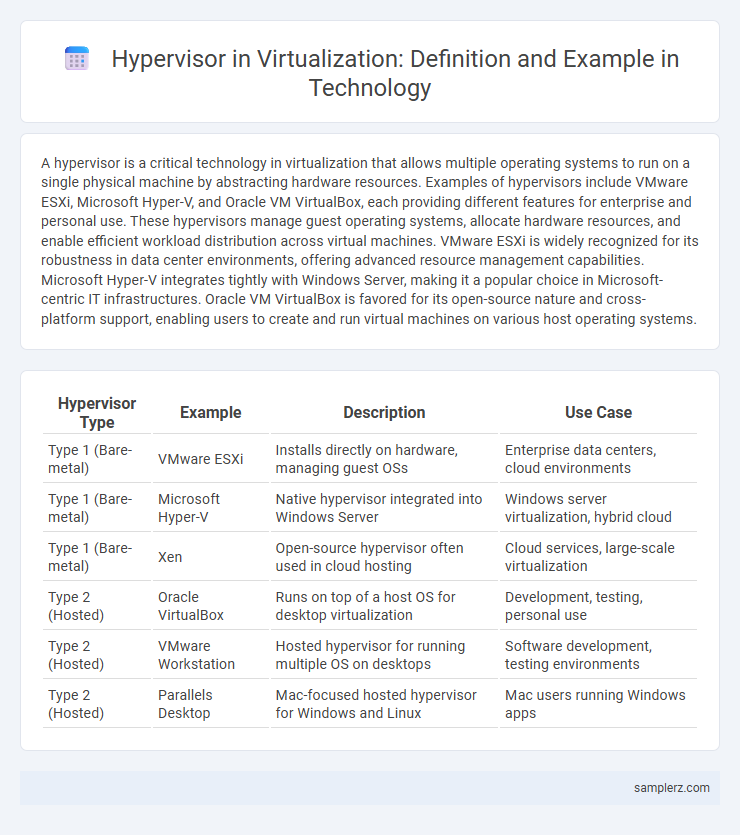A hypervisor is a critical technology in virtualization that allows multiple operating systems to run on a single physical machine by abstracting hardware resources. Examples of hypervisors include VMware ESXi, Microsoft Hyper-V, and Oracle VM VirtualBox, each providing different features for enterprise and personal use. These hypervisors manage guest operating systems, allocate hardware resources, and enable efficient workload distribution across virtual machines. VMware ESXi is widely recognized for its robustness in data center environments, offering advanced resource management capabilities. Microsoft Hyper-V integrates tightly with Windows Server, making it a popular choice in Microsoft-centric IT infrastructures. Oracle VM VirtualBox is favored for its open-source nature and cross-platform support, enabling users to create and run virtual machines on various host operating systems.
Table of Comparison
| Hypervisor Type | Example | Description | Use Case |
|---|---|---|---|
| Type 1 (Bare-metal) | VMware ESXi | Installs directly on hardware, managing guest OSs | Enterprise data centers, cloud environments |
| Type 1 (Bare-metal) | Microsoft Hyper-V | Native hypervisor integrated into Windows Server | Windows server virtualization, hybrid cloud |
| Type 1 (Bare-metal) | Xen | Open-source hypervisor often used in cloud hosting | Cloud services, large-scale virtualization |
| Type 2 (Hosted) | Oracle VirtualBox | Runs on top of a host OS for desktop virtualization | Development, testing, personal use |
| Type 2 (Hosted) | VMware Workstation | Hosted hypervisor for running multiple OS on desktops | Software development, testing environments |
| Type 2 (Hosted) | Parallels Desktop | Mac-focused hosted hypervisor for Windows and Linux | Mac users running Windows apps |
Understanding Hypervisors in Virtualization
Type 1 hypervisors, such as VMware ESXi and Microsoft Hyper-V, run directly on the host hardware to manage virtual machines efficiently. Type 2 hypervisors, like Oracle VM VirtualBox and VMware Workstation, operate on top of a host operating system, providing flexibility for desktop virtualization. Understanding these hypervisors is crucial for optimizing resource allocation and improving system performance in virtualized environments.
Types of Hypervisors: Type 1 vs. Type 2
Type 1 hypervisors, such as VMware ESXi and Microsoft Hyper-V, run directly on the host's hardware, providing superior performance and security by managing guest operating systems at the bare-metal level. Type 2 hypervisors like Oracle VirtualBox and VMware Workstation operate on top of a conventional operating system, making them more suitable for desktop virtualization and testing environments. The primary difference lies in Type 1's direct hardware access versus Type 2's reliance on host OS resources, impacting efficiency and use cases in enterprise versus personal computing.
Key Features of Hypervisor Technology
VMware ESXi exemplifies a leading hypervisor designed for efficient virtualization, supporting direct hardware access to optimize performance and resource allocation. Its key features include robust isolation between virtual machines, enabling secure multi-tenancy, and comprehensive support for live migration to ensure zero-downtime maintenance. Advanced resource management capabilities such as dynamic resource scheduling and scalable architecture enhance overall system efficiency and flexibility in complex virtual environments.
VMware ESXi: Leading Enterprise Hypervisor
VMware ESXi stands as a leading enterprise hypervisor renowned for its bare-metal architecture, enabling efficient virtualization by directly installing on server hardware without an underlying operating system. Its robust features include high scalability, advanced resource management, and seamless integration with VMware vSphere for comprehensive data center automation. Enterprises leverage VMware ESXi to optimize server utilization, enhance workload mobility, and ensure high availability in virtualized environments.
Microsoft Hyper-V: Virtualization in Windows Environments
Microsoft Hyper-V is a leading hypervisor for virtualization in Windows environments, enabling multiple virtual machines to run on a single physical server with enhanced resource management and isolation. It supports a wide range of guest operating systems, including various Windows Server editions, Linux distributions, and FreeBSD, making it versatile for enterprise applications. Hyper-V's integration with Windows Server and Azure enhances hybrid cloud capabilities, providing seamless VM migration, disaster recovery, and scalable infrastructure management.
Oracle VM VirtualBox: Versatile Desktop Virtualization
Oracle VM VirtualBox is a widely used type 2 hypervisor enabling users to run multiple operating systems simultaneously on a single desktop environment. Its versatility supports diverse guest OS platforms, including Windows, Linux, and macOS, optimizing resource allocation and hardware utilization. This virtualization tool enhances development, testing, and legacy application compatibility by providing isolated and efficient virtual machines.
KVM (Kernel-based Virtual Machine): Open-Source Hypervisor Example
KVM (Kernel-based Virtual Machine) is an open-source hypervisor integrated into the Linux kernel, enabling hardware-assisted virtualization on x86 and other architectures. It transforms the Linux operating system into a type-1 hypervisor, providing efficient and secure virtual machine management with support for multiple guest OS instances. KVM's compatibility with QEMU enhances performance and flexibility, making it a preferred choice for cloud infrastructure and enterprise virtualization.
Citrix XenServer: Enterprise-Grade Virtualization
Citrix XenServer is an enterprise-grade hypervisor widely utilized for efficient server virtualization, offering robust support for Windows and Linux virtual machines. It provides advanced features such as live migration, high availability, and centralized management through Citrix Hypervisor Console. Optimized for cloud and data center environments, XenServer delivers scalable performance and seamless integration with Citrix's virtualization ecosystem.
Red Hat Virtualization (RHV): Linux-Based Hypervisor
Red Hat Virtualization (RHV) utilizes KVM (Kernel-based Virtual Machine) as its Linux-based hypervisor, delivering efficient and secure virtualization for enterprise workloads. KVM integrates directly with the Linux kernel, enabling RHV to offer scalable performance and robust resource management across virtual machines. This combination supports advanced features like live migration, high availability, and seamless integration with enterprise cloud environments.
Proxmox VE: Integrated Virtualization Platform
Proxmox VE is a leading open-source hypervisor platform that combines KVM virtualization with container-based virtualization using LXC, offering scalable and efficient resource management. Its integrated web interface facilitates centralized management of virtual machines, storage, and networking, optimizing operational workflows for data centers and enterprise environments. By supporting high availability clustering and live migration, Proxmox VE ensures robust performance and minimal downtime in virtualized infrastructures.

example of hypervisor in virtualization Infographic
 samplerz.com
samplerz.com